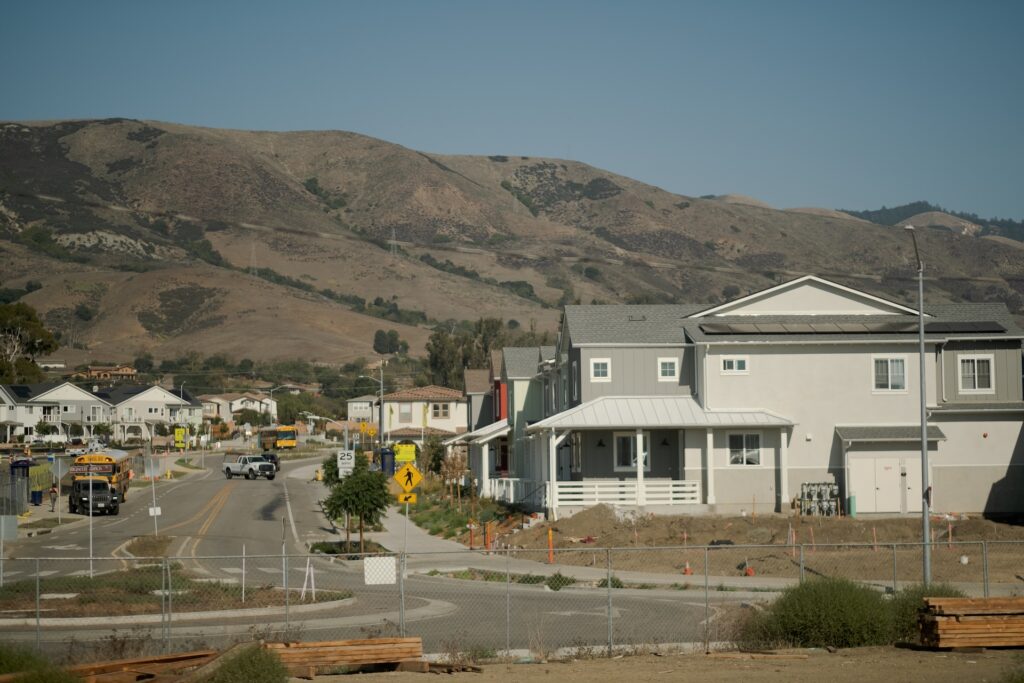Have you ever considered the potential returns of a Build to Rent (BTR) property? You may have heard whispers in the real estate industry about this investment strategy. But what does it mean, and more importantly, how can you tap into its potential?
Build to rent is transforming the landscape of property management – a revolution for landlords and investors alike. It offers a unique blend of steady income, long-term tenants, and the opportunity to shape a community from scratch. But without the right knowledge and strategies, navigating the BTR market can lead you to missed opportunities and unnecessary risks.
In this comprehensive guide, we’re pulling back the curtain on BTR property management. We’ll look into its history, explore current trends, and make some future predictions. You’ll learn how to identify potential BTR properties, evaluate their financial viability, and understand their legalities. We will also share effective property management strategies, the role of technology, and how to mitigate risks.
So, whether you’re a seasoned real estate investor or a landlord looking to diversify your portfolio, this guide is your roadmap to mastering the art of build to rent property management.
Part 1: Understanding the Build To Rent Market

Let’s kick things off by taking a step back in time to understand the origin and evolution of the Build to Rent (BTR) market. The concept started gaining traction in the aftermath of the 2008 financial crisis.
With the traditional housing market in turmoil, investors began to see the potential in purpose-built rental properties. They recognized a shift in societal attitudes toward homeownership, particularly among younger demographics more interested in flexible living arrangements than long-term mortgages.
Fast forward to today, and build to rent is not just a trend but a significant player in the real estate industry. It has proven its resilience even in uncertain times, showing growth during periods when other sectors have stumbled. This robustness stems from its unique model, which aligns the interests of tenants, landlords, and investors, creating a win-win situation for all parties involved.
But what about the future? While no one can predict with complete certainty, the signs are pointing toward continued growth and evolution in the BTR market. Society’s shifting attitudes towards renting, coupled with the increasing demand for community-centric living, suggest that build to rent will continue to grow in popularity and profitability.
Benefits of BTR
As a landlord or investor, the build to rent market presents numerous benefits:
- Steady Income Stream: Unlike selling properties, BTR provides a consistent rental income, offering financial stability and predictability.
- Longer-Term Tenants: Build to rent properties tend to attract tenants who stay longer, reducing the risk and cost associated with high tenant turnover.
- Reduced Vacancy Risk: With longer-term tenants, your properties are less likely to sit vacant, ensuring continuous income.
- Community Building: The opportunity to shape a community from scratch not only attracts tenants but also fosters loyalty, leading to reduced tenant turnover.
- Future-Proof Investment: By offering modern amenities and community living that today’s renters seek, you position your investment for long-term success.
- Resilient Market: The BTR market has shown resilience even in uncertain times, making it a robust investment choice.
- Growing Demand: With societal shifts towards renting and community-centric living, demand for BTR properties is set to increase, offering the potential for growth.
Part 2: Getting Started With Build To Rent

Photo by Bench Accounting on Unsplash
When venturing into the BTR market it’s crucial to arm yourself with the right knowledge. Let’s break down the process into three key steps: identifying potential BTR properties, evaluating financial viability, and understanding legal and compliance requirements.
Identifying Potential BTR Properties
First things first, you need to find properties that are suitable for a build to rent investment. Here are some factors to consider:
- Location, Location, Location: Look for areas with high rental demand, good transport links, and access to local amenities.
- Property Type: Consider what type of property will appeal to your target tenant demographic. Apartments in city centers might be attractive to young professionals, while families might prefer houses in suburban areas.
- Potential for Community Building: BTR is all about creating communities. Properties with shared spaces or potential for communal amenities could be a great fit.
Evaluating Financial Viability
Next up is assessing whether a potential BTR property is financially viable. Here’s what to look at:
- Purchase Price and Renovation Costs: These are your initial outlays. Be sure to account for any necessary renovations to make the property appealing to tenants.
- Projected Rental Income: Estimate your potential income based on local rental rates and occupancy levels.
- Operating Expenses: Don’t forget ongoing costs like maintenance, property management, and insurance.
- Return on Investment (ROI): Finally, calculate your potential ROI. If the numbers add up, you could have a viable build to rent investment on your hands.
Legal Considerations and Compliance Requirements
Last but not least, it’s important to familiarize yourself with the legal aspects of BTR. While this can vary by location, here are some general points to consider:
- Landlord Responsibilities: Understand your obligations regarding property safety, repairs, and tenant rights.
- Lease Agreements: Ensure your lease agreements are legally sound and protect both your interests and those of your tenants.
- Local Regulations: Stay abreast of any local regulations relating to rental properties, including zoning laws and licensing requirements.
Part 3: Effective Property Management Strategies

Now that you’ve identified your potential BTR properties and assessed their financial viability, it’s time to delve into the nitty-gritty of property management. Let’s break this down into three key areas: tenant acquisition, tenant retention, and property maintenance.
Tenant Acquisition: Marketing and Screening Strategies
Attracting the right tenants is crucial in the build to rent market. It involves strategic marketing and rigorous screening processes.
Marketing Strategies
Start by understanding your target tenant demographic. Tailor your advertising to appeal to them, highlighting the features they value most. Utilize online platforms, local listings, and even word-of-mouth referrals to reach a wider audience.
Screening Strategies
Once applications start flowing in, it’s time to screen your prospective tenants. Check for financial stability, rental history, and references. Remember, it’s not just about filling vacancies quickly; it’s about finding reliable tenants who will respect your property and contribute to the community.
Tenant Retention: Building Strong Landlord-Tenant Relationships
Once you’ve secured good tenants, the next step is to keep them. This revolves around building strong relationships based on communication, respect, and responsiveness.
Communication
Maintain open lines of communication with your tenants. Regularly check in with them, listen to their concerns, and show that you value their input.
Respect
Treat your tenants with respect, acknowledging their rights and privacy. Treating others as you would like to be treated fosters a positive landlord-tenant relationship and encourages them to treat your property with care.
Responsiveness
Be prompt in addressing any issues or concerns raised by your tenants. Your attentiveness shows that you care about their comfort and satisfaction, which can significantly boost tenant loyalty.
Property Maintenance: Regular Upkeep and Emergency Repairs
Property maintenance is a vital part of BTR management. It involves regular upkeep to maintain the appeal and functionality of your properties, as well as prompt attention to emergency repairs.
Regular Upkeep
Schedule routine inspections and maintenance tasks to ensure your property remains in top condition. This practice not only prolongs the lifespan of your property but also signals to your tenants that you take pride in providing them with a quality living environment.
Emergency Repairs
Emergencies are inevitable, but how you handle them can set you apart as a landlord. Develop a system for handling emergency repairs swiftly and efficiently. This reassures your tenants that their safety and comfort are your top priorities.
Effective property management is the cornerstone of successful BTR investing. By implementing solid strategies for tenant acquisition, retention, and property maintenance, you’re setting the stage for a prosperous and rewarding venture in the build to rent market.
Part 4: Technology and BTR Property Management

Photo by Carl Heyerdahl on Unsplash
In today’s digital age, technology plays an increasingly important role in the management of build to rent properties. From streamlining operations to enhancing tenant experiences, technology is revolutionizing the way we approach property management.
The Role of Technology in Streamlining Operations
Technology can drastically improve the efficiency of your operations, saving you time and reducing stress. Here are some ways it can help:
- Automated Processes: Automation can take over repetitive tasks like rent collection, lease renewals, and maintenance requests, freeing up your time for more strategic endeavors.
- Digital Communication: With technology, keeping in touch with tenants becomes easier and more efficient. You can send mass notifications, reminders, or updates via email or text, ensuring everyone is kept in the loop.
- Online Marketing: Digital platforms can amplify your property’s visibility, reaching a wider audience of potential tenants. Plus, you can track and analyze your marketing efforts, refining your strategy for better results.
Review of Top Property Management Software
While there are many property management software solutions on the market, it’s crucial to choose one that aligns with your needs. Here are some features to look for:
- Tenant Portal: This allows tenants to pay rent, submit maintenance requests, and communicate with you all in one place. It enhances the tenant experience and simplifies your workload.
- Financial Reporting: Good software should offer comprehensive financial reporting, helping you track income, expenses, and overall performance of your properties.
- Maintenance Management: Look for software that helps manage maintenance tasks, from scheduling regular checks to handling emergency repairs.
Part 5: Risks and Challenges in BTR Property Management

Like any investment, build to rent comes with its own set of risks and challenges. By understanding these potential pitfalls and implementing strategies to mitigate them, you can protect your investment and set yourself up for success.
Common Pitfalls and How to Avoid Them
Here are some common challenges in BTR property management and how you can sidestep them:
Vacancy Risk: Having unoccupied properties can drain your resources. To avoid this, focus on tenant retention strategies, keep your properties well-maintained, and ensure your rents are competitive.
Bad Tenants: Problematic tenants can cause damage, pay rent late, or create disturbances. A thorough screening process can help you filter out such tenants from the onset.
Unexpected Maintenance Costs: Repairs and maintenance can sometimes hit you unexpectedly and throw off your budget. Regular property inspections can help you spot potential issues early and address them before they escalate.
Strategies for Mitigating Risks
While you can’t eliminate all risks, you can certainly mitigate them. Here are some strategies to consider:
Insurance: Ensure you have adequate landlord insurance coverage for your properties. This can protect you against a range of scenarios, from property damage to liability claims.
Contingency Planning: Always have a plan B. Whether it’s having a reserve fund for unexpected costs or a backup tenant lined up in case of vacancies, contingency planning can save you from many headaches.
Legal Compliance: Stay on top of legal requirements and regulations. Non-compliance can lead to hefty fines or legal issues. Consulting with a real estate attorney can help you navigate this complex area.
Unleashing Your BTR Potential

There you have it – a comprehensive journey into the world of build to rent property management. We’ve explored its roots, current landscape, and potential future. We’ve shared insights on identifying BTR properties, evaluating their financial viability, understanding legalities, and managing them effectively.
But keep in mind that knowledge is only powerful when applied. So, take these insights, strategies, and tips, and put them into action. Start scanning your local real estate market for BTR opportunities. Crunch the numbers, consider the legal implications, and imagine the community you could create.
Remember, every property giant started with a single investment. Build to rent could be the start of a thriving real estate portfolio. So why not take that step today? Embrace the world of BTR and see where it takes you.

Take charge of your investment with Achieving Financial Success as a Property Manager: An Insider’s Guide! This invaluable resource provides all the essential information and strategies you need to excel in rental property management. Get your copy today from your favorite bookseller:
- Amazon
- Books2Read for Apple, Barnes & Noble, Kobo, Scribed, and 8 more sellers with both eBook and paperback options available
- Payhip as a PDF
Now is the time to become an expert in this exciting field – don’t miss out!
Content created by J. Scott Digital freelance copywriting services.







